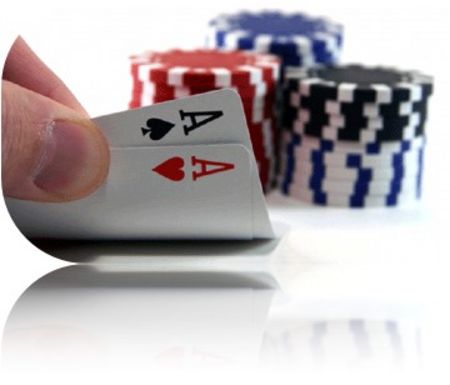Two-Suited

When the flop is two-suited against several opponents, you should usually fold if
you suspect that the bettor has at least top pair. Your outs are reduced and even
when you do hit your hand, there is a decent probability you could lose on the river.
Advanced concept: Almost always fold middle or bottom pair when the flop is two-suited and you are
against three or more opponents, unless the pot is very large.
To demonstrate this concept, let's look at your possible outs assuming at least one
of your opponents has a better hand and one opponent has a flush draw. You could
have either 5, 4, 3, 2, 1, or 0 outs depending on the circumstances. For example,
with a flop of J
♦ 7 ♣ 5
♦:
- 5 outs: You hold A ♦ 5 ♣
- 4 outs: You hold A ♣ 5 ♣ (the A ♦ is counterfeited)
- 3 outs: You hold A ♣ 7 ♠ (A ♦ and 7 ♦ is counterfeited)
- 2 outs: You hold A ♣ 7 ♦ and an opponent has A ♦ J ♠
- 1 out: You hold A ♣ 7 ♠ and an opponent hay A ♦ J ♠
- 0 outs: You could be drawing practically dead depending on your opponents'
holdings.
The best case scenario in this example is that you have five outs, which has the
added benefit of a backdoor flush draw. However, calling against several opponents
is usually not justified since there is a higher probability that your outs are
counterfeited.
Strategy against one or two opponents is more complicated. You could have the
best hand. A bettor may be semi-bluffing with a flush draw. When they do hold a
hand, you may have all five outs since there are not so many opponents to
counterfeit your hand.
Generally bet out against one or two opponents to see how they react, especially
when they have already checked and you are acting last. If raised, you have a
difficult decision to make that is often based on the type of opponent you are
against. Most opponents who check-raise probably have a strong hand, while a
raise in late position may just be an attempt to buy a free card. A good
understanding of your opponent's playing style should help you with these difficult
decisions.
The same thinking applies when you are against one or two opponents and an
opponent bets into you. Are they the type of opponent who would bet out a flush
draw? You might have the best hand depending on the type of opponent you are
against. It is difficult to give concrete rules when playing against one or two
opponents, as there is a greater chance that your opponents could be semi-bluffing.
Study your opponents and evaluate their tendencies to help you make better
decisions in these situations.
Two-Connected
When there are two connected high cards, you should usually fold against several
opponents. You have to worry about straight draws and the possibility that you are
already against two pair since many opponents play connected cards. An
opponent's hand might counterfeit your kicker card. For example, with a QJ7 flop
and you hold A7 or AJ, be inclined to fold against several opponents. If you hit your
ace, an opponent could either be hitting a straight or two better pair.
Against one or two opponents, strategy is usually dependent on the pot odds and
the bettor's tendency to semi-bluff. If the two connected cards are low, you do not
need to worry so much about straight draws, unless an opponent played out of the
blinds or from late position.
NEXT...
Rainbow with One High Card

